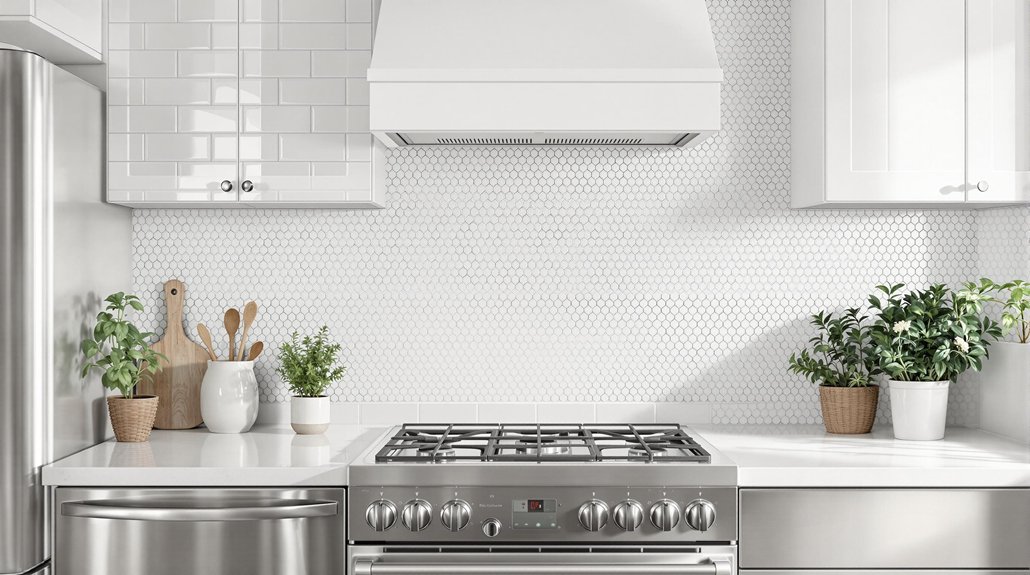
16 White Kitchen Tile Ideas That Feel Fresh and Timeless
White kitchen tiles remain timeless and flexible, blending elegance with the latest design trends. Options like classic white squares, traditional and modern metro tiles, hexagonal patterns, and subtly patterned or large format styles can refresh any kitchen. Textured Zellige, matchstick, or marble tiles add visual and tactile interest. Contrast techniques—such as black grout—provide dynamic edge, while mixing with wood and neutral cabinetry softens the look. Discover unique layouts and finishing touches that enhance this enduring palette.
Key Takeaways
- Classic white subway or metro tiles arranged in herringbone or brick patterns offer timeless appeal and suit both modern and traditional kitchens.
- Subtly textured or patterned white tiles add depth and character without overwhelming a neutral kitchen scheme.
- Hexagonal and geometric white tiles create fresh visual interest and can modernize even small or awkward kitchen spaces.
- Pairing white tiles with black grout delivers striking contrast, highlighting tile shapes and adding a contemporary edge.
- Large-format or marble-effect white tiles provide a seamless, luxurious look while making kitchens feel brighter and more spacious.
Classic White Square Tiles
Classic white square tiles remain a staple in kitchen design, valued for their understated elegance and adaptability across diverse interior styles. Their simple form guarantees versatility, allowing them to seamlessly complement both contemporary and traditional kitchens.
White square tiles offer timeless elegance and effortless versatility, making them a perfect fit for any kitchen style.
When classic white square tiles are paired with black grout, the result is a sophisticated contrast that heightens visual appeal and defines each tile’s outline. This bold pairing not only enhances depth but also introduces a subtle graphic edge.
For those seeking to infuse kitchens with additional interest, arranging these tiles in a diamond pattern introduces a dynamic geometric element, moving beyond standard layouts.
Damask Blanco, a recommended option, exemplifies this aesthetic, striking a balance between timelessness and modern flair while remaining cost-effective for budget-conscious renovations.
Traditional-Style Metro Tiles
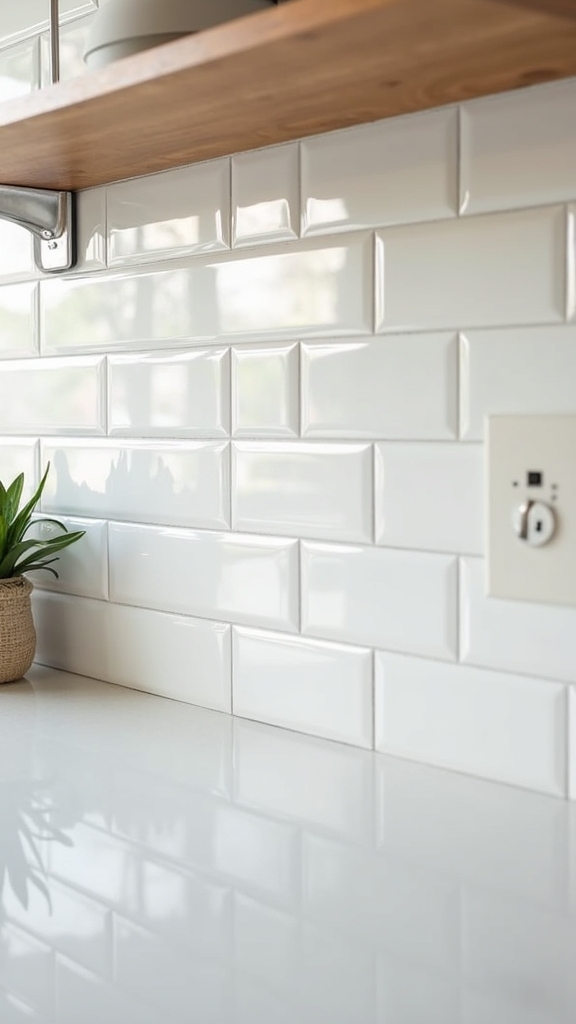
Metro tiles, with their iconic beveled edges and glossy surfaces, remain a favored choice in kitchen design for their ability to bridge tradition and modernity.
Traditional-style metro tiles, particularly in classic white, offer a timeless look that seamlessly adapts to a range of kitchen aesthetics. Their versatility allows installation in classic brick bond or elegant herringbone layouts, introducing visual interest and subtle dimension to the space.
For added sophistication, moulded border tiles can be paired with these metros, delivering a refined finishing touch. Dorset Blanco is a recommended option, prized for its enduring appeal and compatibility with various color schemes.
Furthermore, traditional-style metro tiles present an affordable yet stylish solution, making them especially attractive for homeowners seeking a budget-friendly kitchen refresh. A butcher block island can enhance the kitchen’s overall warmth and functionality, complementing the timeless appeal of metro tiles.
Modern Metro Tiles
Modern metro tiles bring a sleek, stacked layout to white kitchens, emphasizing clean lines and an effortless contemporary style.
Their unfussy design, exemplified by the crisp Emilia Blanco tile, creates a bright and spacious backdrop that feels both refined and adaptable.
This approach allows for seamless integration with bold accents or minimalist finishes, reinforcing a modern aesthetic with subtle sophistication.
Sleek Stacked Layouts
When arranged in sleek stacked layouts, metro tiles introduce a crisp, contemporary edge to kitchen design, emphasizing clean lines and visual order.
Modern metro tiles are celebrated for their versatility, allowing for a minimalist aesthetic that feels both fresh and timeless. The stacked configuration departs from classic brick patterns, creating a streamlined, grid-like surface that amplifies the sense of space and light.
This approach produces a clean canvas, making it easy for vibrant accents or distinctive appliances to stand out against the understated tilework.
With options ranging from glossy to matte finishes, modern metro tiles in sleek stacked layouts adapt seamlessly to a variety of kitchen styles, always maintaining a contemporary look that prioritizes simplicity, sophistication, and effortless coordination with other design elements.
Effortless Contemporary Style
A growing number of contemporary kitchens embrace the effortless appeal of modern metro tiles, favoring their clean lines and adaptable layouts.
In white kitchens, these tiles offer a versatile canvas that underscores an effortless contemporary style.
Modern metro tiles excel in both vertical and horizontal stacking, providing a streamlined effect that aligns with modern design sensibilities.
Their unfussy design and sleek finish, as seen in options like Emilia Blanco, enhance the simplicity and elegance of the space without overpowering other elements.
The result is a seamless flow throughout the kitchen, where sophistication is achieved through minimalism.
This understated approach allows modern metro tiles to blend harmoniously with cabinetry and fixtures, creating a fresh, timeless aesthetic that feels both current and enduring.
White Tiles With Black Grout
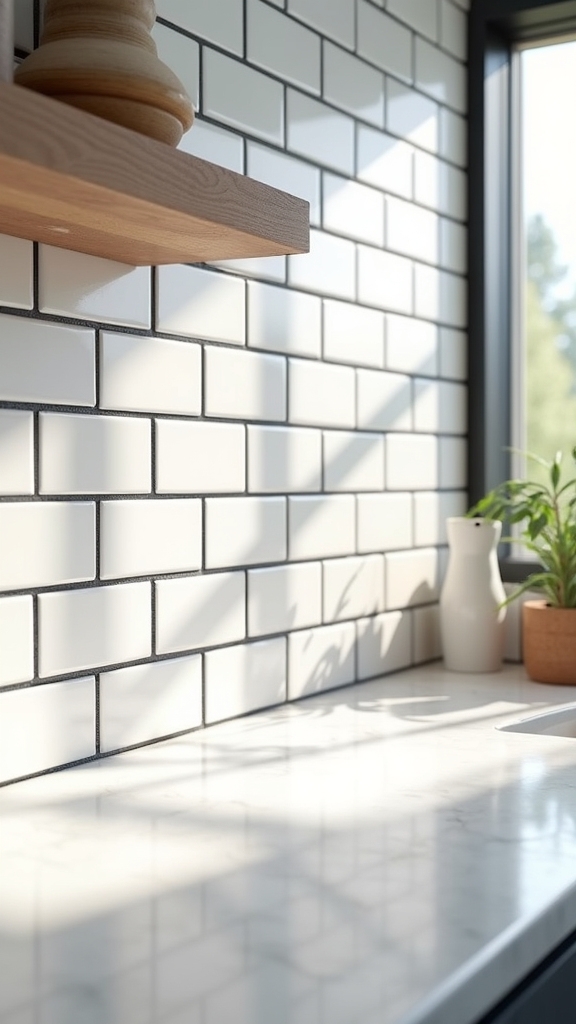
White tiles paired with black grout achieve a sharp contrast that immediately draws attention, elevating even the simplest layouts.
This combination not only enhances the crisp geometry of patterns like subway or herringbone, but also accentuates individual tile shapes for a graphic effect.
The result is a visually dynamic backdrop that feels both timeless and distinctly modern.
Enhancing Classic Contrast
Though a monochrome palette may seem simple, pairing crisp white tiles with bold black grout creates a striking visual contrast that instantly enhances kitchen design.
This approach, particularly when using classic white subway tiles, delivers an effortless blend of tradition and modern feel. The black grout not only outlines each tile for a graphic, sophisticated effect but also offers practical benefits.
For homeowners seeking enduring style, this combination stands out for its versatility and ease of maintenance.
- Visual Emphasis: Black grout frames white tiles, highlighting their shape and layout.
- Contemporary Edge: The pairing modernizes traditional subway tiles for a chic, updated look.
- Practical Maintenance: Dark grout conceals stains, ideal for busy kitchens.
- Versatile Appeal: Works seamlessly with minimalist, industrial, and transitional design styles.
Highlighting Tile Patterns
When black grout outlines white kitchen tiles, the resulting contrast draws immediate attention to the geometry and artistry of the tile arrangement. This design-forward pairing is more than a visual statement—it is a strategic choice for those looking to highlight tile patterns within the kitchen.
Whether using classic subway white tiles or opting for intricate herringbone layouts, black grout acts as a bold frame, emphasizing each shape and line. The graphic effect produced by this combination delivers a contemporary twist to timeless surfaces, adding dimensionality and character.
Additionally, black grout is practical, concealing dirt and stains while maintaining a crisp look. The interplay between white tiles and black grout allows homeowners to showcase both traditional and modern tile patterns with striking, trend-aware results.
Hexagonal Tiles
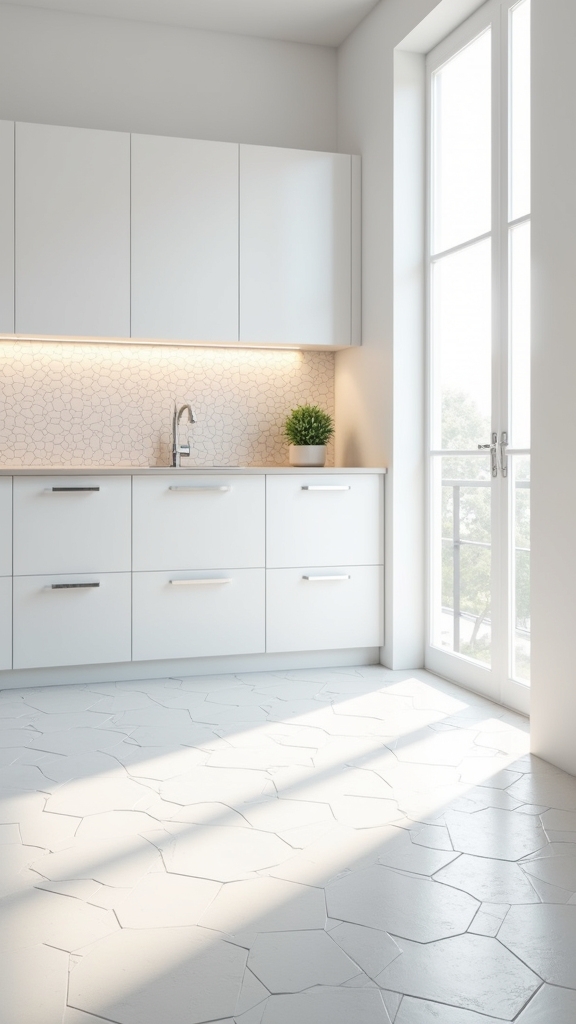
While classic subway tiles remain popular, hexagonal tiles introduce a dynamic geometry that instantly modernizes kitchen spaces. Their distinctive shape brings visual interest, elevating kitchen design with a geometric pattern that feels both fresh and timeless.
The adaptability of hexagonal tiles makes them an excellent choice for unconventional layouts, particularly in kitchens with awkward corners or limited wall space. For those seeking understated elegance, the Ava Blanco Plain tile offers simplicity and versatility, acting as a sophisticated canvas for creative installations.
Consider the following design strategies:
- Arrange hexagonal tiles to create seamless shifts on backsplashes and feature walls.
- Incorporate subtle texture or accent colors for added depth and personality.
- Use contrasting grout to accentuate the geometric pattern and shape.
- Mix matte and gloss finishes for nuanced visual interest.
Adding vintage wooden stools can inject rustic charm into contemporary kitchens, creating a unique blend of different design eras.
Subtly Patterned White Tiles
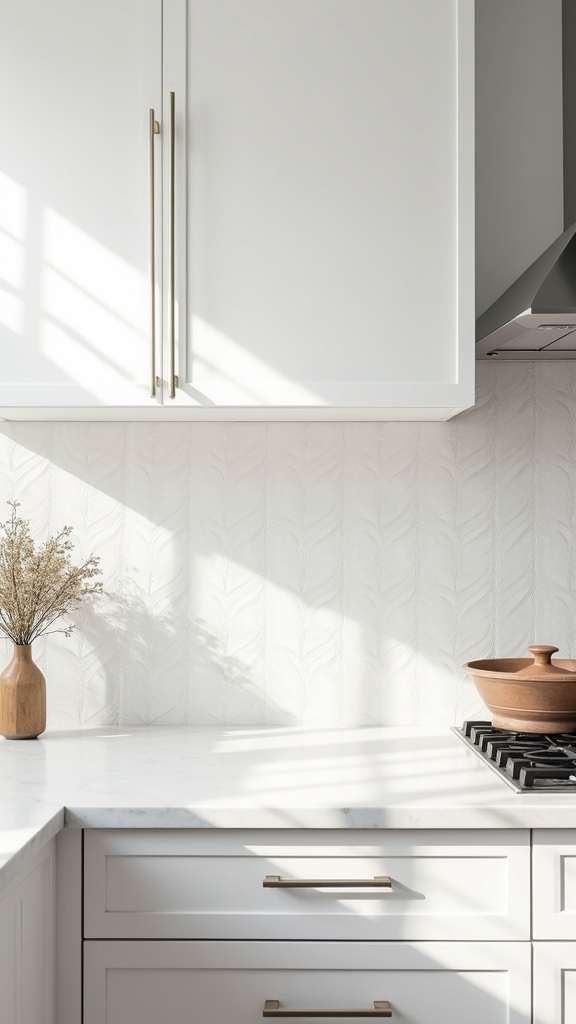
Building upon the geometric intrigue of hexagonal tiles, subtly patterned white tiles offer a refined way to infuse character into kitchen spaces without disrupting a neutral color scheme.
These tiles bring a layer of visual interest through gentle textures or understated surface variations, enhancing the freshness of white while preserving a clean aesthetic. Designers appreciate their versatility; subtly patterned white tiles can be combined with a range of cabinetry finishes, countertops, and metallic fixtures, allowing for creative yet harmonious kitchen designs.
The result is a space that feels both classic and unique, balancing timeless appeal with modern sensibilities. For those seeking to uplift a white kitchen, the Canyon Mosaic tile exemplifies how subtle patterning can add depth and character without overwhelming the overall look.
Zellige Style Tiles
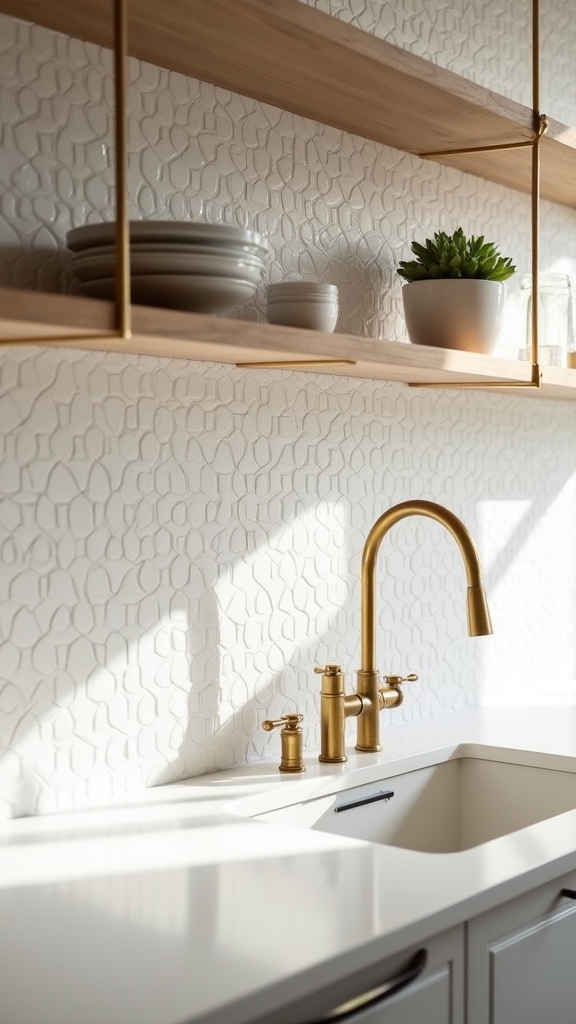
Zellige style tiles bring an artisanal touch to white kitchens through their uneven texture, adding visual depth and subtle movement to splashbacks.
When installed closely together, these handmade tiles create a striking, cohesive surface that balances rustic charm with modern appeal.
Their distinctive finish makes them an ideal choice for those seeking both character and timeless elegance.
Uneven Texture Adds Depth
Handcrafted tiles with an uneven, artisanal texture introduce depth and dimension to white kitchens, making each space feel both sophisticated and inviting.
Zellige style tiles, in particular, are prized for their nuanced surface variations, which play with light and shadow to great effect. The irregularities inherent in each tile create a subtle tactile experience, elevating the kitchen’s overall design.
When considering how to incorporate this textured depth, note the following:
- Zellige tiles should be installed tightly together to emphasize their distinct, handcrafted look.
- Each tile’s unique surface guarantees that no two kitchens will look exactly alike.
- The glossy glaze enhances brightness, reflecting light to enliven the space.
- These artisanal tiles effortlessly complement both modern and traditional kitchen aesthetics, offering timeless appeal.
Rustic Charm for Splashbacks
While many white kitchens aim for a crisp, minimalist look, introducing Zellige style tiles as splashbacks infuses the space with rustic charm and visual intrigue.
These handcrafted tiles, celebrated for their uneven texture, lend kitchen splashbacks a unique visual appeal that stands apart from conventional ceramic options. Zellige tiles bring subtle depth through their natural imperfections, capturing and reflecting light in unexpected ways.
Available in various finishes and shades of white, they offer designers the flexibility to customize the palette while maintaining a cohesive, timeless aesthetic.
The artisanal quality of each tile guarantees no two surfaces are exactly alike, making the splashback a personalized focal point.
Integrating Zellige tiles enhances even the simplest kitchen, imparting character and enduring style.
Close-Set Installation Impact
A close-set installation of Zellige style tiles introduces a refined sense of continuity and depth to kitchen splashbacks, utilizing the tiles’ uneven surfaces for maximum visual impact.
This approach not only highlights the rustic charm inherent in Zellige tiles but also creates an understated yet enchanting focal point within the kitchen.
By minimizing grout lines, the close-set installation allows the handcrafted texture and luminous glaze of each tile to take center stage, producing a cohesive and enhanced look.
For those seeking a design-forward statement, consider these key benefits:
- Accentuates the unique, hand-formed details of Zellige tiles.
- Establishes a seamless, visually rich splashback as a focal point.
- Enhances warmth and character, balancing modernity with rustic charm.
- Offers versatile layout possibilities for creative kitchen expressions.
Decorative Tile Layouts
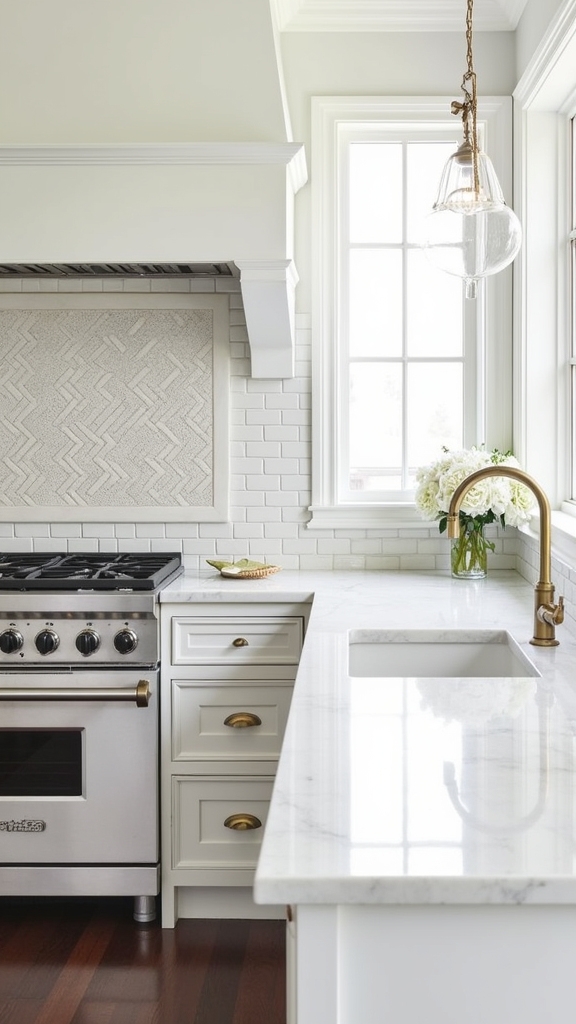
Countless contemporary kitchens benefit from the impact of decorative tile layouts, which transform simple white tiles into striking design elements. By employing patterns like herringbone or brick bond, homeowners introduce visual interest that enhances the classic appeal of white kitchen tiles.
Incorporating border tiles within a decorative layout can frame the backsplash and define cooking zones, offering a refined and cohesive look. Mixing tile shapes and sizes strategically adds depth and highlights architectural features, ensuring certain areas become intentional focal points.
Varied panel designs can punctuate expanses of white, breaking up uniformity while maintaining harmony. Regular maintenance is required for grout lines to ensure longevity and preserve the aesthetic appeal of the decorative tiles. Ultimately, a thoughtfully executed decorative layout allows white kitchen tiles to transcend their simplicity, crafting a sophisticated yet inviting backdrop that underscores personal style and enhances the kitchen’s overall atmosphere.
Matchstick Tiles
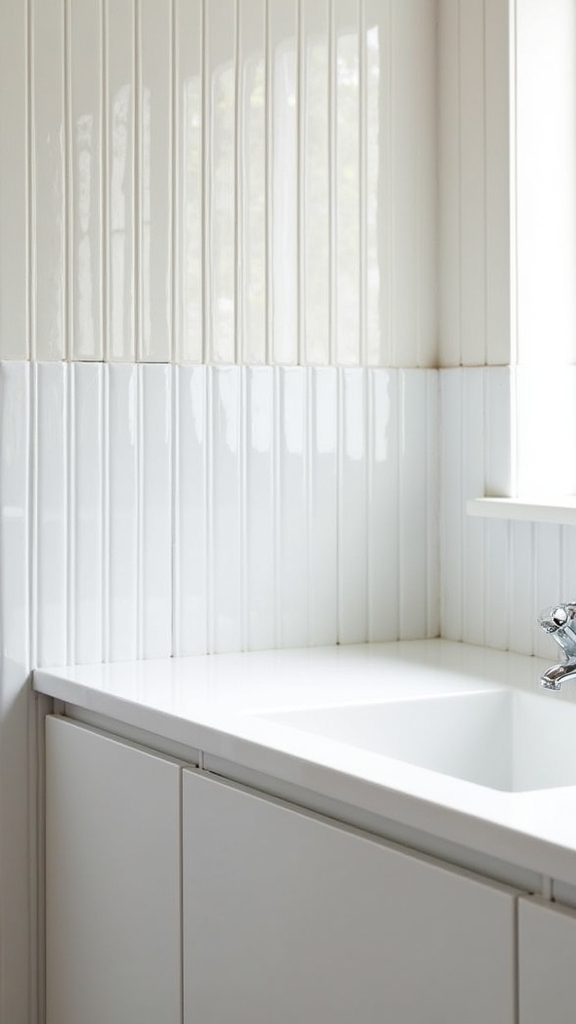
Matchstick tiles, inspired by modern Japanese design, bring a sleek linear profile to white kitchen spaces.
Their elongated shape offers flexibility, making both vertical and horizontal layouts possible for a tailored, contemporary effect.
This approach not only underscores minimalist aesthetics but also introduces subtle movement and visual interest to the backsplash.
Modern Japanese-Inspired Design
Sleek lines and subtle texture define the modern Japanese-inspired kitchen, where long, narrow porcelain tiles—often referred to as matchstick tiles—bring a refined sense of order to the backsplash.
Rooted in Japanese aesthetics, this modern design element complements the minimalist appearance often sought in a contemporary kitchen. The unique texture of matchstick tiles adds visual interest while maintaining an uncluttered, cohesive backdrop.
Their versatility in color and finish enables homeowners to personalize the space or embrace a timeless monochromatic palette.
For those curating a sophisticated kitchen, matchstick tiles offer:
- Enhanced minimalist appearance through clean, uninterrupted lines
- Subtle texture that raises the backsplash without overwhelming
- Flexibility in pattern and color selection for personalized impact
- A seamless blend of traditional Japanese influence with modern sensibilities
Vertical or Horizontal Layouts
Building upon the refined appeal of Japanese-inspired matchstick tiles, the orientation of these slender porcelain pieces plays a pivotal role in defining a kitchen’s atmosphere.
Vertical layouts elongate walls, imparting the illusion of higher ceilings and bringing openness to compact spaces. In contrast, horizontal installations visually widen a kitchen, reinforcing a contemporary sensibility that adapts effortlessly to both modern and transitional styles.
The sleek appearance of matchstick tiles—characterized by their clean, uninterrupted lines—adds a streamlined, chic edge to any backsplash.
Beyond their directional impact, these tiles invite creative experimentation with finishes, from glossy to matte, and subtle tonal variations in white.
This versatility allows homeowners and designers to craft uniquely personal spaces while maintaining an enduring, timeless quality in the kitchen’s design.
Marble Tiles
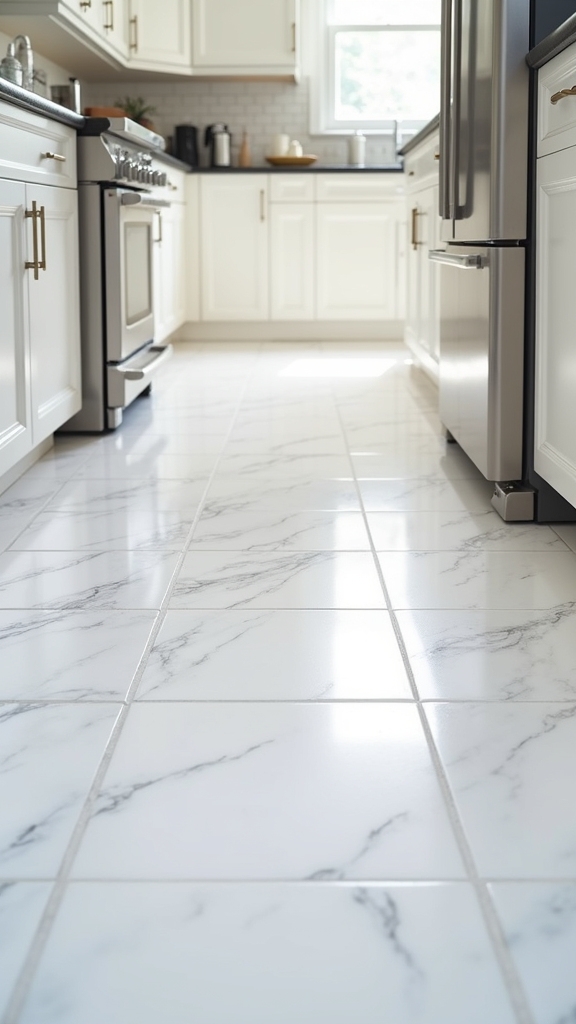
Timeless sophistication defines marble tiles, making them a coveted choice for white kitchen splashbacks. The inherent luxury of marble tiles enhances the ambiance, instantly infusing a kitchen with a refined, luminous quality.
Designers favor this timeless choice for its ability to create a luxurious aesthetic while remaining versatile and classic. Distinct veining patterns in each tile guarantee unique visual interest and a tactile charm that stands apart from other materials. For those seeking both function and beauty, marble remains unmatched.
Consider these design-forward applications:
- Large format marble slabs for seamless, modern appeal.
- Classic herringbone mosaics for intricate textural detail.
- Subtle veining for understated elegance in minimalist kitchens.
- Strategic placement as a feature backsplash to maximize impact without exceeding budget.
Complementing White Tiles With Neutral Cabinetry
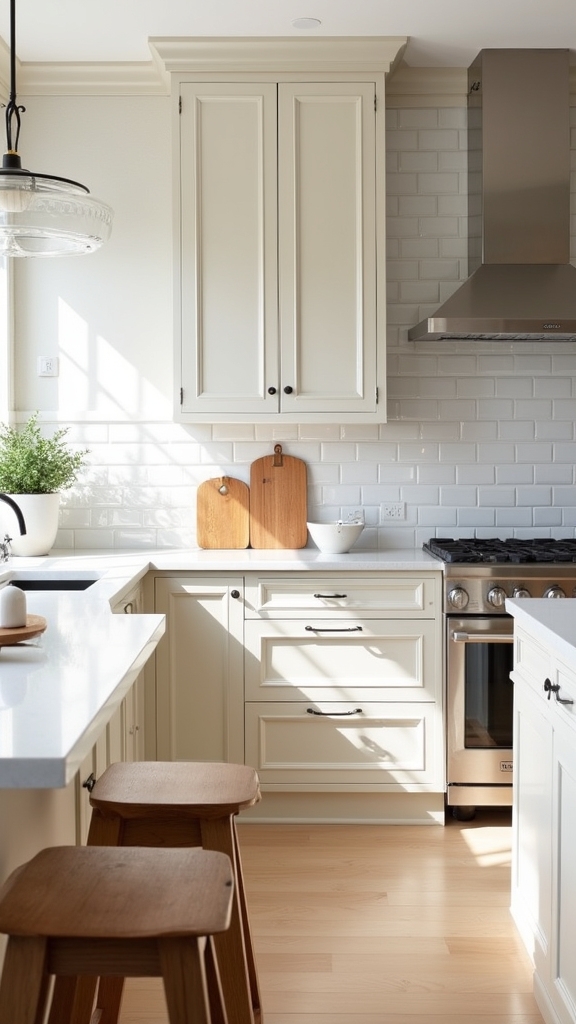
A refined approach to kitchen design pairs white tiles with neutral cabinetry, resulting in an effortlessly sophisticated backdrop. Soft cream or pale sage green units create a sense of harmony, blending seamlessly with bright white surfaces to evoke tranquility and openness. This combination works particularly well in compact spaces, where the cohesive palette enhances brightness and the perception of space. Warm wooden cabinetry adds inviting depth and texture, striking a perfect balance between modernity and coziness. For those seeking a subtle design twist, white herringbone tiles introduce visual interest without overwhelming the room. Neutral cabinetry also allows white tiles to serve as a versatile canvas, providing flexibility for future updates. The result is a timeless, trend-aware kitchen that feels fresh and welcoming year-round. Incorporating greige cabinets can further extend the warmth and sophistication of a modern kitchen, blending seamlessly with various design styles for timeless appeal.
Creating a Neutral Backdrop for Bold Accents

When white kitchen tiles are used as the primary surface, they establish a crisp, neutral foundation that amplifies the impact of bold accents throughout the space. This design approach is favored for its ability to create a visually uncluttered kitchen space, making each accent color or statement piece more pronounced.
A neutral backdrop of white tiles opens avenues for experimentation, ensuring versatility and timelessness. To maximize this aesthetic, consider the following:
- Use white wall tiles to let vibrant cabinetry or appliances take center stage.
- Extend white tiles to floors for heightened visual contrast with bold accessories.
- Introduce pops of color through décor and furniture, ideal for minimalist or Scandinavian kitchens.
- Pair off-white tiles with natural woods for warmth without sacrificing freshness.
Large Format White Tiles for a Contemporary Look

While contemporary kitchens often prioritize sleekness and simplicity, large format white tiles offer a sophisticated solution that visually expands the space.
These tiles are prized for their ability to create a seamless, expansive backdrop, thanks to minimal grout lines that enhance the kitchen’s airy feel. Typically crafted from durable porcelain, large format white tiles bring both longevity and a polished finish to modern interiors.
Their reflective surfaces boost natural light, making even compact or dimly lit kitchens feel brighter and more open. Designers often select various sizes and opt for grid or staggered patterns, lending subtle visual interest while preserving a clean, uncluttered effect.
Beyond their striking contemporary look, large format tiles are low-maintenance, with fewer grout lines simplifying cleaning—an ideal choice for busy households.
Incorporating Patterned White Tiles
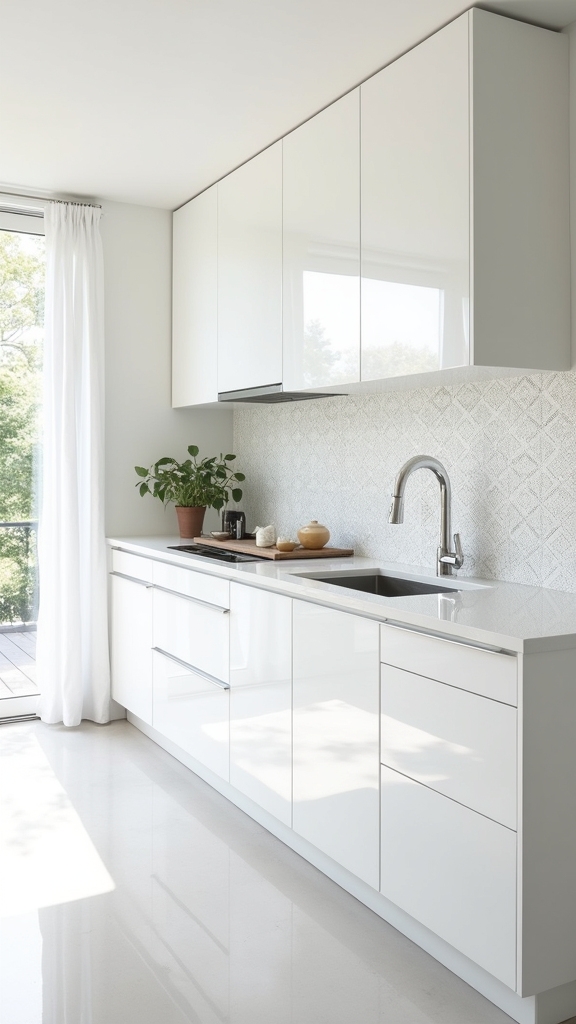
Beyond the sleek uniformity of large format tiles, patterned white tiles offer an opportunity to infuse kitchens with personality without sacrificing the timeless appeal of a neutral palette.
Classic motifs—such as checkerboard or delicate stars—add interest and a touch of vintage character, while their white base guarantees cohesion within the space.
For a sophisticated, balanced look, consider these design strategies:
- Limit patterned white tiles to either the floor or a feature wall to prevent visual overwhelm.
- Select subtle patterns to enhance freshness and maintain versatility across kitchen styles.
- Echo accent colors from patterned tiles in cabinetry or accessories for a harmonious, tied-together effect.
- Combine patterned and plain white tiles to maximize airiness and add visual interest without clutter.
These approaches raise the kitchen’s aesthetic with effortless refinement.
Mixing Textures for Depth and Interest
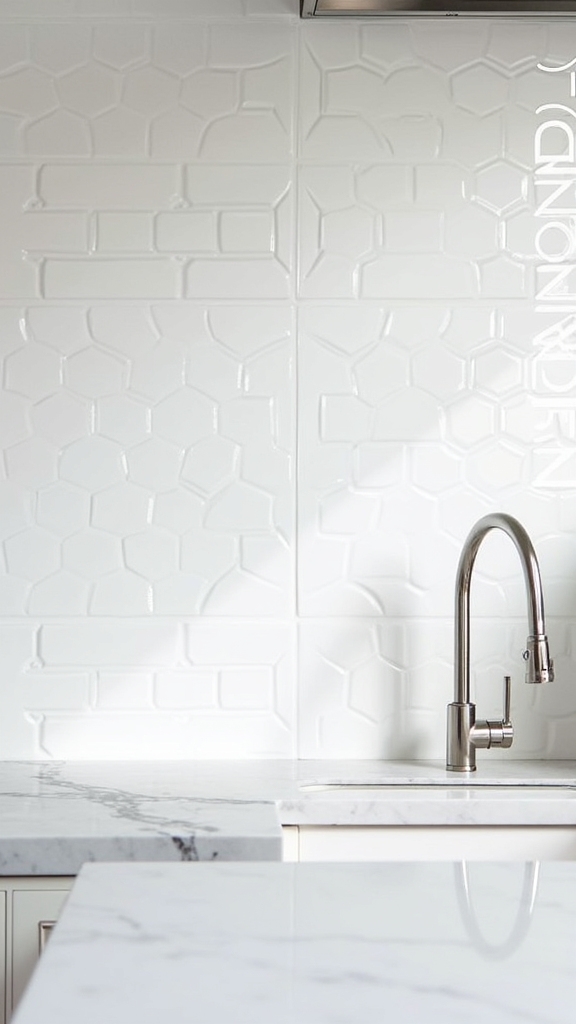
Glossy subway tiles catch and reflect light, offering a crisp counterpoint to the understated elegance of matte finishes.
In contemporary kitchens, mixing textures through the strategic use of white tiles introduces visual interest and depth without disrupting the serene palette.
Rustic, handcrafted white tiles set against sleek porcelain surfaces create a nuanced, layered effect, bringing character to the space.
Textured options such as Zellige tiles or subtly patterned pieces can function as focal points, contrasting with smooth tiles and offering a tactile dimension.
The use of contrasting grout, like dark hues with matte white tiles, further accentuates the texture and dimensionality.
With careful selection and placement, mixing textures enhances a white kitchen, ensuring the design feels both fresh and timeless rather than flat or sterile.
Pairing White Tiles With Natural Elements

Building on the dynamic effects created by varied textures, white tiles achieve even greater impact when paired with natural elements throughout the kitchen.
The seamless blend of crisp surfaces and organic materials brings warmth, depth, and a cohesive design sensibility to the space. To enhance the look, consider these sophisticated pairings:
- Natural wood—such as reclaimed cabinetry or a statement island—softens the coolness of white tiles, fostering a welcoming ambiance.
- Stone countertops, like granite or marble, introduce texture and elegance, complementing the simplicity of white tiles.
- Greenery in the form of potted herbs or fresh foliage infuses life and vibrancy, creating a fresh, organic atmosphere.
- Woven accents—rattan or wicker bar stools and light fixtures—enrich the natural aesthetic, adding warmth and visual interest.
Incorporating natural materials and textures like wood, stone, and metal enhances the rustic appeal of the kitchen, balancing the clean lines of white tiles with a cozy and inviting atmosphere.
Frequently Asked Questions
Is an All-White Kitchen a Timeless Design Choice?
An all-white kitchen remains a timeless design choice due to its enduring all white aesthetics, versatile kitchen color palettes, classic white cabinetry styles, and the ability to highlight functional design elements while maintaining a bright, open, and sophisticated atmosphere.
What Are the Latest Trends in White Kitchens?
Current trends in white kitchens emphasize minimalist accents, contrasting textures like matte cabinetry with glossy countertops, and statement lighting. Colorful backsplashes introduce personality, while curated simplicity and interplay of materials create visually dynamic yet uncluttered, design-forward environments.
How to Design a Timeless White Kitchen?
To design a timeless white kitchen, one should prioritize a functional kitchen layout, classic cabinet styles, durable countertop materials like quartz or marble, and thoughtfully selected lighting fixtures that highlight the space’s clean lines and enhance a bright, welcoming ambiance.
How Do You Add Warmth to an All-White Kitchen?
To introduce warmth to an all-white kitchen, designers often layer warm accents, select natural materials like wood, prioritize strategic lighting choices, and incorporate textured elements such as woven baskets or ceramics, resulting in a balanced, inviting atmosphere.
Conclusion
White kitchen tiles remain an enduring favorite, offering both versatility and sophistication. From classic squares to contemporary large formats and textured finishes, each tile style brings its own character while maintaining a timeless appeal. Pairing white tiles with natural elements or bold grout can refresh a space without sacrificing elegance. Ultimately, these thoughtfully chosen tile designs guarantee a kitchen that feels both current and inviting, effortlessly blending modern trends with enduring style.

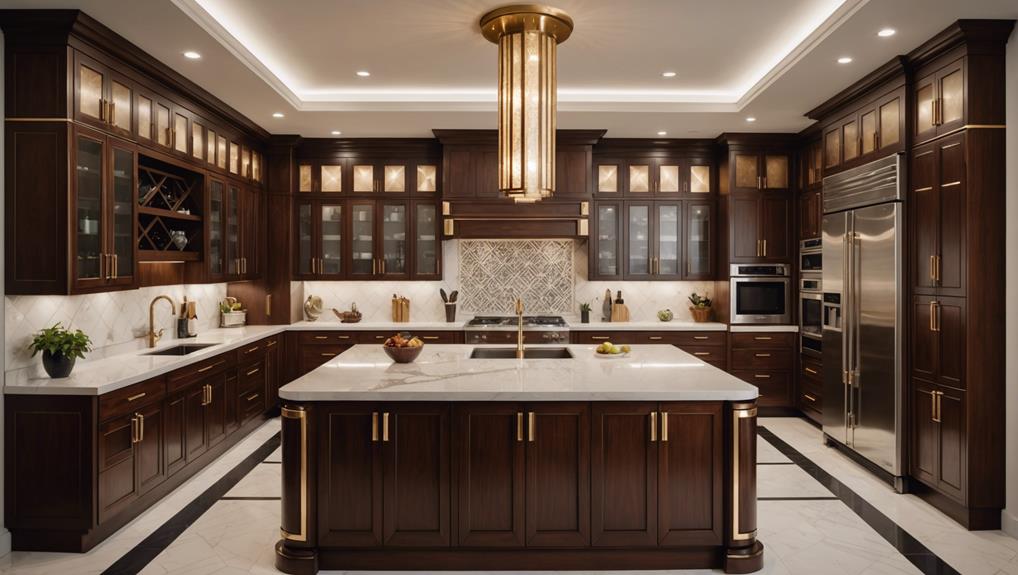
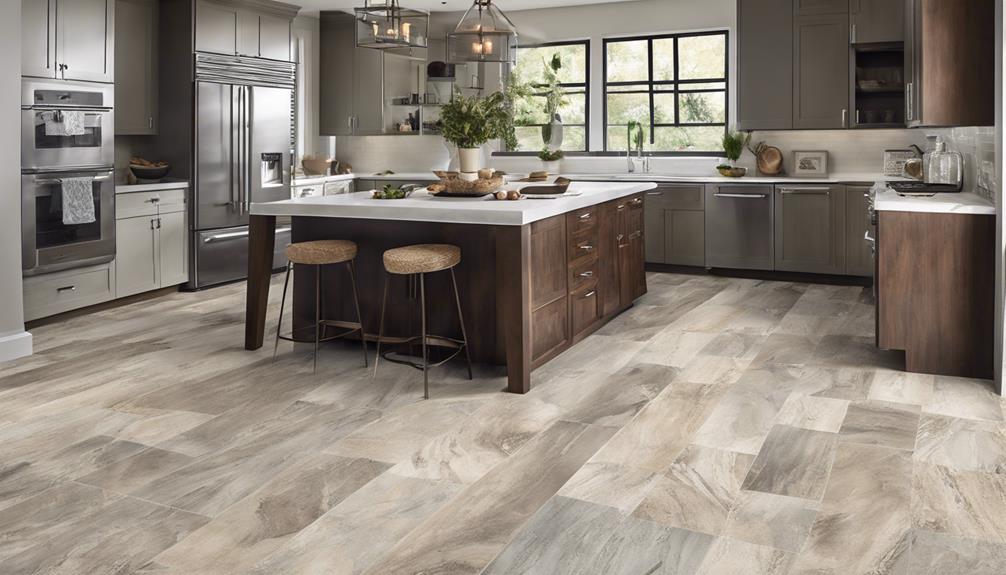
Leave a Reply